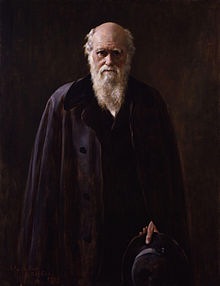
In 1881 Darwin was an eminent figure, still working on his contributions to evolutionary thought that had had an enormous effect on many fields of science.
During Darwin's lifetime, many geographical features were given his name. An expanse of water adjoining the
Beagle Channel was named
Darwin Sound by
Robert FitzRoy after Darwin's prompt action, along with two or three of the men, saved them from being marooned on a nearby shore when a collapsing
glacier caused a large wave that would have swept away their boats,
and the nearby
Mount Darwin in the Andes was named in celebration of Darwin's 25th birthday.
When the
Beagle was surveying Australia in 1839, Darwin's friend
John Lort Stokes sighted a natural harbour which the ship's captain
Wickham named
Port Darwin: a nearby settlement was renamed
Darwin in 1911, and it became the capital city of Australia's
Northern Territory.
More than 120
species and nine
genera have been named after Darwin.
In one example, the group of
tanagers related to those Darwin found in the
Galápagos Islands became popularly known as "
Darwin's finches" in 1947, fostering inaccurate legends about their significance to his work.
Darwin's work has continued to be celebrated by numerous publications and events. The
Linnean Society of London has commemorated Darwin's achievements by the award of the
Darwin–Wallace Medal since 1908.
Darwin Day has become an annual celebration, and in 2009 worldwide events were arranged for the bicentenary of Darwin's birth and the 150th anniversary of the publication of
On the Origin of Species.
Darwin has been commemorated in the UK, with his portrait printed on the reverse of £10 banknotes printed along with a
hummingbird and the
HMS Beagle, issued by the
Bank of England.

0 comments:
Post a Comment